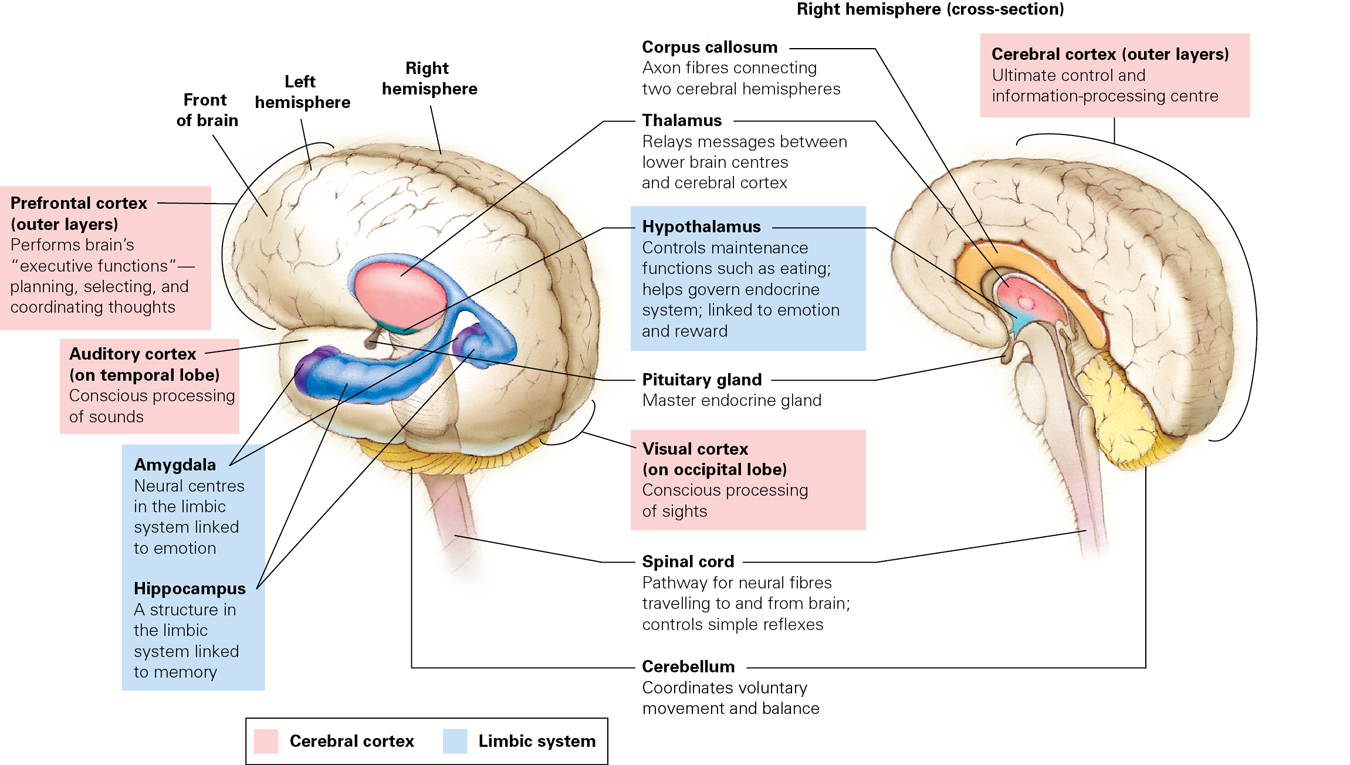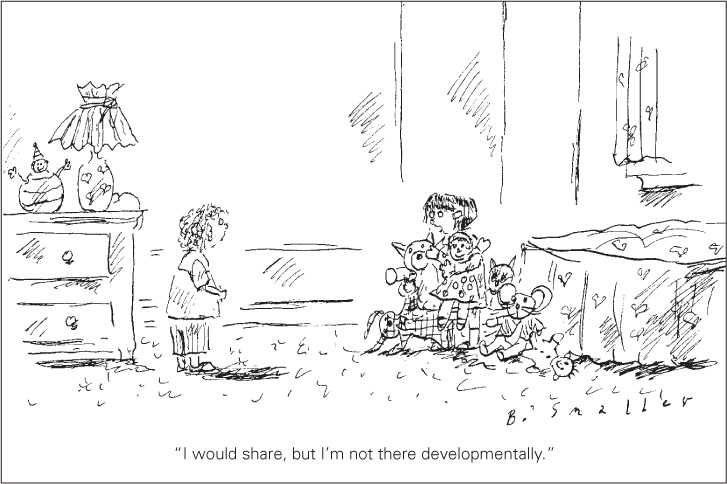5.2 Brain Development
As with motor skills, the brains of young children show impressive growth, but are not nearly as developed as they will be later on. By age 2, most neurons are connected to other neurons and substantial pruning has occurred. The 2-

The Maturing Cortex
Since most of the brain is already present and functioning by age 2, what is still developing? The most important parts!
Although the 2-
Considered from an evolutionary perspective, human brains have allowed the species to develop “a mode of living built on social cohesion, cooperation and efficient planning…survival of the smartest,” which seems more accurate than survival of the fittest (Corballis, 2011). Those functions of the brain that distinguish us from apes begin in infancy but develop notably after age 2 years, enabling quicker, better coordinated, and more reflective thought (Johnson, 2010; Kagan & Herschkowitz, 2005).
185
Between the ages of 2 and 6 years, neurological increases are especially notable in the cortex regions, where planning, thinking, social awareness, and language occur. Elephants, crows, chimpanzees, and dolphins have all surprised researchers with their intelligence, but none come close to Homo sapiens in the relative size of the cortex or its capacity for social understanding (Corballis, 2011). For example, researchers gave a series of tests to 106 chimpanzees, 32 orangutans, and 105 human 2½-year-
One part of the cortex in particular is much larger in humans than in any other creature. That is the prefrontal cortex, a brain area right above the eyes that is called the executive of the brain because planning, prioritizing, and reflection occur there. It is the prefrontal cortex that, for instance, allows young children to begin to plan ahead as well as to think about experiences they have had, for instance deciding who they want at their birthday party or what they liked best about a summer trip. The pre-
Speed of Thought
Most of the increases in brain weight after infancy are the result of myelination. Myelin (sometimes called the white matter of the brain) is a fatty coating on the axons that speeds signals between neurons (see Figure 5.4). Although myelination continues for years, the effects are especially apparent in early childhood (Silk & Wood, 2011).

186
Speed of thought from axon to neuron becomes pivotal when several thoughts and actions must occur in rapid succession. By age 6, most children can see an object and immediately name it, catch a ball and throw it, and write their ABCs in proper sequence, to name a few accomplishments. In fact, rapid naming of letters and objects—
Of course, adults must be patient when listening to young children talk, helping them get dressed, or watching them write each letter of their names. Everything is done more slowly by 6-
Impulsiveness and PerseverationThe young child’s inability to speedily combine thoughts is evident when both action and reflection are needed. Neurons have only two kinds of impulses: on–
Many young children have not yet found the balance. They are impulsive, going from one activity to another. That explains why many 3-
Shapes and ColoursPerseveration gradually declines in every child. Consider a series of experiments in which 3-
ESPECIALLY FOR Early Childhood Teachers You know you should be patient, but you feel your frustration rising when your young charges dawdle as they walk to the playground a block away. What should you do? 
One solution is to remember that the children’s brains are not yet myelinated enough to enable them to quickly walk, talk, or even button their jackets. Maturation and experience have major effects. 
When this result was first obtained, researchers thought that 3-
Researchers are looking into many possible explanations for this result (Marcovitch et al., 2010; Müller et al., 2006; Yerys & Munakata, 2006). All agree, however, that something in the brain matures between ages 3 and 5 to enable children to switch their way of sorting objects.
Connecting Hemispheres
One part of the brain that grows and myelinates rapidly during early childhood is the corpus callosum, a long, thick band of nerve fibres that connects the left and right sides of the brain. Growth of the corpus callosum makes communication between hemispheres more efficient, allowing children to coordinate the two sides of the brain or body. Failure of the corpus callosum to mature results in serious disorders; this is one of several possible causes of autism (Frazier & Hardan, 2009), discussed in Chapter 7.
187
ESPECIALLY FOR Neurologists Why do many experts think that identifying the limbic system as the regulator of emotions is an oversimplified explanation of brain function? 
The more we discover about the brain, the more complex we realize it is. Each part has specific functions and is connected to every other part. 
The two sides of the body and of the brain are not identical. Typically, the brain’s left half controls the body’s right side, as well as areas dedicated to logical reasoning, detailed analysis, and the basics of language; the brain’s right half controls the body’s left side, with areas dedicated to emotions, creativity, and appreciation of music, art, and poetry. This left–

Some research a decade ago found that, relatively speaking, the corpus callosum was thicker in females than in males, a finding that led to speculation about women’s superior emotional understanding. However, research using more advanced techniques now finds that this sex difference is far from universal. Some individual males and females have notably thicker corpus callosa than others, but gender does not seem relevant (Savic, 2010).
Although gender does not seem to affect thickness of the corpus callosum, handedness might. Left-
Often cultures assume everyone should be right-
Developmentalists advise against switching a left-
188
Emotions and the Brain
Now that we have considered the prefrontal cortex and the corpus callosum, we turn to the major brain region for emotions, sometimes called the limbic system. Emotional expression and emotional regulation advance during early childhood (more about that in the next chapter), and crucial to that advance are three major areas of the limbic system—
The amygdala is a tiny structure deep in the brain, named after the Greek word for almond because it is about the same shape and size. It registers emotions, both positive and negative, especially fear (Kolb & Whishaw, 2008). Increased amygdala activity is one reason some young children have terrifying nightmares or sudden terrors, overwhelming the prefrontal cortex and disrupting reason. Children may refuse to enter an elevator, or will hide when they hear thunder. Specifics depend on the child’s innate temperament as well as on past social experiences (Tarullo et al., 2011).
Another structure in the brain’s limbic system, the hippocampus, is located right next to the amygdala. A central processor of memory, especially memory for locations, the hippocampus responds to the anxieties of the amygdala by summoning memory. A child can remember, for instance, whether previous elevator riding was scary or fun. Memories of location are fragile in early childhood because the hippocampus is still developing.
The interaction of the amygdala and the hippocampus is sometimes helpful, sometimes not; fear can be constructive or destructive (LaBar, 2007). Studies performed on some animals show that when the amygdala is surgically removed, the animals are fearless in situations that should scare them; for instance, a cat will stroll nonchalantly past monkeys—
A third part of the limbic system, the hypothalamus, responds to signals from the amygdala (arousing) and to signals from the hippocampus (usually dampening) by producing cortisol and other hormones that activate parts of the brain and body (see Figure 5.3). Ideally, this hormone production occurs in moderation (Tarullo & Gunnar, 2006).

189
As the limbic system develops, young children watch their parents’ emotions closely (the social referencing described in Chapter 4). If a parent looks worried when entering an elevator, the child may fearfully cling to the parent when the elevator moves. If this sequence recurs often enough, the child’s amygdala may become hypersensitive to elevators, as fear joins the hippocampus in remembering a specific location, and the result is increased cortisol. If, instead, the parent seems calm and makes elevator riding fun (letting the child push the buttons, for instance), the child will overcome initial feelings of fear, and the child might run to the elevator, happily pushing buttons.
Knowing the varieties of fears and joys is helpful if a teacher takes a group of young children on a trip. To stick with the elevator example, one child might be terrified while another child might rush forward, pushing the close button before the teacher enters. Every experience (elevators, fire engines, animals at the zoo, a police officer) is likely to trigger a range of emotions, without much reflection, in a group of 3-
KEY Points
- The prefrontal cortex develops in early childhood and beyond, allowing the planning and analyzing that comprise executive processing.
- Myelination speeds mental processing, which eventually reduces impulsivity and perseveration.
- Emotional regulation requires coordination of several brain areas, including the amygdala, the hippocampus, and the hypothalamus.
- Brain maturation of young children is more advanced, especially in social understanding, than in other animals, but each child’s particular culture and experience have a notable impact.